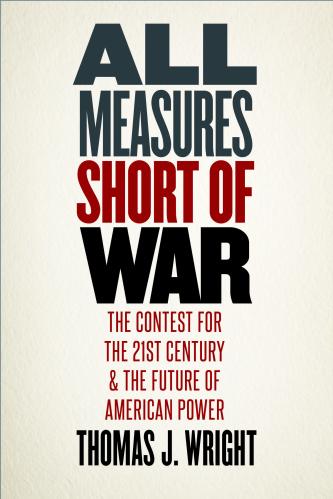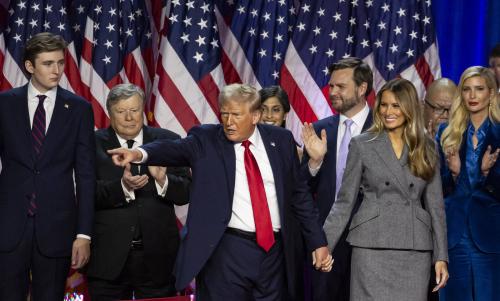During his distinguished tenure as 19th chairman of the Joint Chiefs of Staff—the nation’s highest-ranking military officer—General Joseph Dunford has been a key force at the center of America’s defense policy. He has helped redirect U.S. strategic attention to the challenges posed by great power competition, while also remaining vigilant against threats from the Korean Peninsula to the Persian Gulf and broader Middle East, and addressing rapidly evolving military technologies as well as other challenges.
On May 29, the Brookings Institution hosted General Dunford for a sweeping conversation on U.S. defense policy with Senior Fellow Michael O’Hanlon, beginning with an introduction by Brookings President John R. Allen.
O’Hanlon opened by asking General Dunford to assess the international security environment, and how it has evolved since he assumed his current position in 2015. Dunford said that since 2015, Russia has intensified its operations in the Donbas, intervened in the Syrian conflict, conducted an attempted assassination operation in the United Kingdom, and then interfered in the U.S. elections while modernizing its nuclear enterprise. China has become more aggressive in the South China Sea on top of the current economic friction, while North Korea remains as uncertain as ever.
O’Hanlon turned to Russia, where Dunford has an established dialogue with General Valery Gerasimov—chief of the general staff of Russia’s armed forces—to deconflict operations and reduce the risk of miscommunication that could lead to unintended exchanges between U.S. and Russian forces. O’Hanlon argued that despite recent Russian disinformation and aggression, military deterrence of Russia is more stable in part because of the role Dunford and others have successfully played in building up the European Defense Initiative, while NATO has become more focused on the task of deterring Russia in the east. Dunford responded: “When I think about military-to-military relationships, I think about it in terms of mitigating a risk and miscalculation, and then managing a crisis,” noting that he and his Russian counterpart have been committed to separating politics from their ongoing professional dialogue.
On NATO, Dunford said: “We made a fundamental shift…to truly enhance deterrence as well as assurance. I would argue that the investments we have made as a nation in Europe…have in fact improved our posture in Europe from what it was four years ago, and have in fact improved deterrence.” Dunford lauded the Europeans’ growing cohesion by highlighting “the most recent commitment by Europe to have 30 battalions, 30 ships, and 30 squadrons available in 30 days, and in an unprecedented way, to expose those units to their validation of readiness by the Supreme Allied Commander of Europe—something that was never done in the past.”
O’Hanlon raised North Korea, and “just how much [U.S.-South Korea] readiness might have been degraded by the suspension of exercises” during President Trump’s recent diplomatic overtures to Kim Jong Un. Dunford replied: “I am very confident today that we have not compromised the readiness of the alliance to go to war should that be required.” He explained: “At the squadron and the battalion level there has been no change to training on the peninsula. And of course, that is the fundamental building block of the ability to integrate and combine arms to fight on the peninsula. There has been no change in that regard.”
Moving to China, O’Hanlon raised Beijing’s efforts to build up military capability in the South China Sea. From 2013 to 2015, there was significant reclaiming of the islands, followed by the positioning of military forces despite Xi Jinping’s promise to President Obama not to. Dunford underscored that China’s militarization—today, there are 10,000-foot runways, ammunition storage facilities, routine deployment of missile defense capabilities—is a concern, and that if the militarization of the islands has plateaued, as O’Hanlon noted, “it’s because the islands have now been developed to the point that they provide the military capability China required.” Dunford stressed that the South China “is in my judgment not a pile of rocks…and what is at stake [there] and elsewhere where there are territorial claims, is the rule of law, international laws, norms, and standards.” He concluded that those who violate norms “need to be held accountable so that future violations are deterred.”
Finally, O’Hanlon asked Dunford to assess the state of readiness of the U.S. military “as it tries to get on the comeback trail from a pretty rough first 20 years of this century.” Dunford recounted that in 2010, the military made two faulty assumptions: that operational commitments would reduce, and the fiscal environment would stabilize. While the decisions made in 2011 and onward were informed by those assumptions, by 2015 it became clear that the operational environment was not going to change, and the fiscal situation was not going to stabilize. At that point, the military started to achieve a better balance, and “in 2017, I would argue that we began to see adequate levels of funding to be able to address those issues.” With better planning and a more realistic sense of operational commitments informed by the National Defense Strategy, “we’re now what I hope to be four years into stable and adequate levels of funding, assuming that we get fiscal year [20]20 at or about what the president’s budget reflects. And that has made a quantifiable impact on the level of readiness that we have.”
On the broader dilemma of quality versus quantity in the U.S. military, Dunford explained that “if we’re going to grow capacity, you need to do it in a way where it is meaningful capability, balanced capability. And when you have to make a choice between capacity and capability, I would go with capability.”
Gen. Dunford: “When you have to make a choice between capacity and capability, I would go with capability.”
During the audience Q&A session, Dunford was asked how the threat posed by Iran to the United States and U.S. forces in the region changed over the last year. Dunford replied that the U.S. intelligence community began to observe multiple threat streams in Yemen, the Gulf, and Iraq that prompted the United States to send a clear message: Iran would be held “accountable should something take place in the region.” Because there were questions about the will and capability of the United States to respond, Dunford—together with General McKenzie of U.S. Central Command—made a number of specific recommendations to Acting Secretary of Defense Shanahan to “address what I saw as a gap in perception…We wanted the Iranians to know that if they did anything, it would be attributable to them.” Dunford stressed: “This was all designed to enhance deterrence.”
Asked on President Trump’s decision to station troops on the southern border with Mexico, while Dunford refused to comment on the appropriateness of diverting funding from the Pentagon’s budget to that effort, he refuted the idea that it negatively impacted the military’s readiness in any way. In any task assigned to U.S. forces, “we make sure that we rotate the units routinely through different missions to give them experience and training and capability in the full spectrum of missions that we expect them to perform. So I don’t view the mission on the border differently with regard to readiness from any other mission that we’ve been assigned.”




Commentary
At Brookings, Gen. Joseph Dunford comments on threats from Russia, China, North Korea, and beyond
June 4, 2019